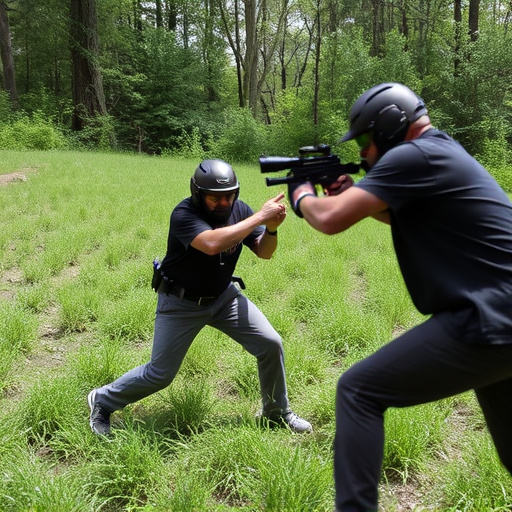Stun guns, marketed as non-lethal alternatives to firearms, deliver high-voltage, low-amperage electric current to temporarily incapacitate targets. While effective, these devices carry significant neurological risks, including disorientation, memory lapses, muscle spasms, and potential severe complications like seizure disorders and cognitive impairments with prolonged or repeated use. Amperage, a key factor determining effectiveness, varies across models; higher amperages intensify side effects. Balancing power and safety requires users to understand amperage ratings, follow guidelines for responsible use, and prioritize nervous system health. Global regulations mandate minimum safety standards, age restrictions, and licensing to mitigate these neurological risks, with some regions setting amperage limits to prevent permanent harm. Understanding stun gun amperage is crucial for law enforcement and self-defense contexts, emphasizing the need for proper training and safety protocols.
Electrical shock weapons, particularly stun guns, have sparked both interest and controversy. This article delves into the intricate details behind these devices, focusing on amperage—a critical factor in their effectiveness and potential neurological side effects. From understanding the science of stun guns to exploring real-world case studies, we uncover the impact of high-voltage shocks. By addressing common misconceptions and legal considerations, this comprehensive guide sheds light on the true nature of stun gun amperage and its accompanying neurological implications.
- Understanding Electrical Shock Weapons: A Brief Overview
- The Science Behind Amperage and Its Role in Stun Guns
- Neurological Effects of High-Voltage Shock
- Common Misconceptions About Stun Gun Safety
- Regulatory and Legal Aspects of Electrical Shock Devices
- Case Studies: Real-World Implications of Stun Gun Amperage
Understanding Electrical Shock Weapons: A Brief Overview

Electrical shock weapons, commonly known as stun guns or tactical electronic control devices (TECDs), are non-lethal weapons designed to temporarily incapacitate a target through electrical impulses. These devices emit high-voltage, low-amperage electric current, disrupting the nervous system and causing muscle contractions. The primary goal is to stun and control an individual without causing permanent harm, making them popular among law enforcement and self-defense enthusiasts.
While stun guns are marketed as safe alternatives to traditional firearms, they can still lead to various neurological side effects. Short-term symptoms may include disorientation, memory lapses, and muscle spasms. Prolonged exposure or repeated shocks might result in more severe complications, such as seizure disorders, cognitive impairments, and even long-term nerve damage. Understanding these potential risks is crucial for users to make informed decisions and ensure their safety.
The Science Behind Amperage and Its Role in Stun Guns

The effectiveness of stun guns, or electrical shock weapons, lies in their ability to deliver a precise and powerful electric current. At the core of this technology is the concept of amperage—a measure of electric charge flow. When activated, these devices release a high-voltage, low-amperage electrical pulse, designed to disrupt muscle control and cause temporary paralysis without causing serious physical harm. The specific amperage varies across models, but it’s crucial in determining the weapon’s impact. Higher amperages can lead to more intense neurological side effects, such as disorientation, muscle spasms, and in extreme cases, even respiratory distress.
Understanding amperage is essential when considering the potential risks and effectiveness of stun guns. While these devices are marketed as non-lethal, the electrical current’s effect on the body’s nervous system cannot be overlooked. The balance between delivering a powerful enough shock to incapacitate an assailant and minimizing the risk of severe neurological damage is a delicate one. Thus, users must be aware of the amperage ratings and follow safety guidelines to ensure responsible use.
Neurological Effects of High-Voltage Shock

High-voltage shocks from stun guns or similar devices can have significant neurological effects due to their intense electric current. These effects range from temporary disorientation and muscle spasms to, in extreme cases, loss of consciousness and even long-term sensory impairments. The electricity disrupts normal nerve function, causing rapid depolarization and repolarization of cellular membranes, leading to a cascade of physiological responses.
One of the key neurological side effects is the potential for neuromuscular incapacitation, where the electric current temporarily paralyses muscles, making it difficult or impossible for the individual to move. This can lead to a loss of balance and coordination, contributing to falls and further injuries. Prolonged exposure to high-voltage shocks may also result in long-lasting sensory disturbances, including altered sensation, numbness, or even permanent damage to nerve endings, affecting touch, temperature perception, and pain sensitivity.
Common Misconceptions About Stun Gun Safety

Many people believe that stun guns are safe and harmless, often assuming they only cause temporary numbness or discomfort. However, this is far from the truth. Stun guns deliver high-voltage electrical shocks designed to disrupt an attacker’s muscular control, but these devices can also lead to significant neurological side effects. The intensity of the current can cause nerve damage, seizures, and even cardiac arrhythmias in severe cases.
Another common misconception is that stun guns are only effective for self-defense against humans. In reality, they can also stun animals, causing them extreme pain and potentially leading to serious injuries or death. It’s crucial to understand the full scope of these weapons’ capabilities to ensure safe and responsible use, as mishandling or misunderstanding their effects could have severe consequences.
Regulatory and Legal Aspects of Electrical Shock Devices

The regulatory and legal landscape surrounding electrical shock devices, such as stun guns, varies significantly across jurisdictions. In many countries, these devices are subject to strict controls due to potential risks associated with their use. The primary concern is often the neurological side effects of electric shocks, which can range from temporary disorientation and muscle contractions to more severe consequences if the current is high enough.
Legal frameworks typically mandate minimum safety standards, age restrictions for ownership and use, and specific licensing requirements for individuals or organizations that manufacture, sell, or carry such devices. Some regions also regulate the amperage levels permitted in stun guns, ensuring they are designed to incapacitate without causing permanent harm. This regulatory oversight aims to balance the potential benefits of self-defense tools with the need to protect citizens from unnecessary harm and ensure public safety.
Case Studies: Real-World Implications of Stun Gun Amperage

In real-world scenarios, the amperage delivered by stun guns and similar electrical shock weapons has significant implications on human health, particularly regarding neurological side effects. Case studies have shown that even low amperage devices can cause temporary but severe physiological responses, including muscle spasms, loss of balance, and cognitive impairments. These effects are attributed to the rapid depolarization of nerve cells, leading to a disruption in neural signaling and communication within the body.
Research into stun gun neurological side effects has revealed that higher amperage weapons can result in more severe consequences. Prolonged or repeated exposure to high-amperage shocks may lead to long-term sensory disturbances, memory issues, and even permanent nerve damage. These findings underscore the importance of understanding the specific amperage ratings of stun guns and their potential impact on individuals, especially in law enforcement and self-defense contexts where proper training and safety protocols are crucial to mitigate risks associated with electrical shock weapons.
Electrical shock weapons, particularly stun guns, have sparked interest and controversy alike. Understanding the science behind amperage and its role in delivering shocks is crucial to discerning their effectiveness and potential neurological side effects. While these devices claim non-lethal capabilities, real-world implications highlight the importance of regulatory oversight. By examining case studies and staying informed about stun gun amperage, users can make more conscious decisions regarding their safety and responsible use.
